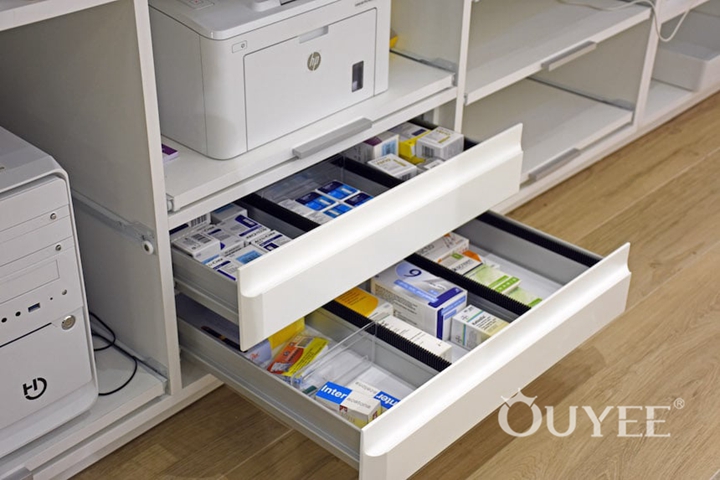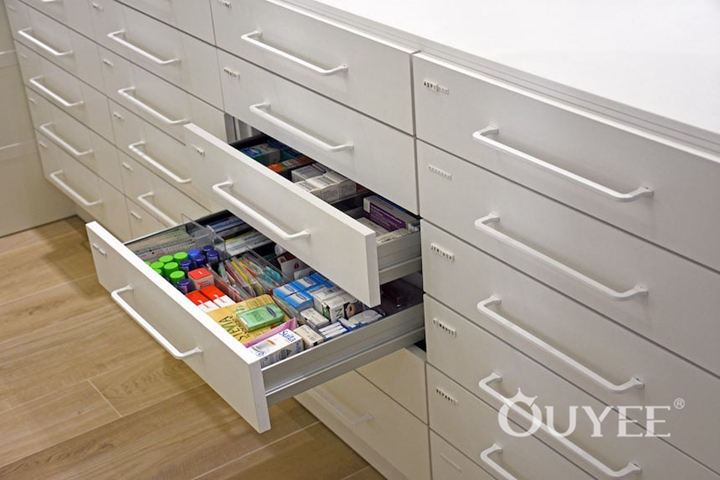“The pharmacy is easily accessible through a wide, automatic opening door with a push button for wheelchair users. The open plan layout assists customers… the pharmacy is well maintained and… it clearly presents a professional image befitting of a health care setting. No stock was stored in the consultation room or in other parts of the pharmacy used by patients.”
If reading this makes you feel uncomfortable about the current state of your pharmacy, or if you are simply keen to improve your business’s potential, then it could be time to refit your premises.

The importance of careful planning
With the cost of an average pharmacy refit coming in at £40,000–£80,000, achieving a return on this investment is imperative. The most successful refits happen in those pharmacies that are clear from the start about what they want to achieve. Spending four weeks planning for a two-week refit is not unusual and it will be time well spent, says Andy Conduit, sales director of Summit Retail Display Limited of Sittingbourne. “It will speed up the time spent on the refurbishment, minimise disruption to your trading, and also avoid any nasty shocks or surprises,” he says.

During the planning stage, pharmacy staff should take a hard look at their reasons for wanting a refit, which may include making the dispensary workflow more efficient and getting the space allocation right for your turnover/profit centres. “You don’t want dispensary staff stepping over each other and wasting time walking around unnecessarily,” says Richard Kay, director of Pharma Storage Solutions of Great Harwood, Lancashire. “The ideal outcome is when prescription items are going in and out of the dispensary as quickly as possible.” In many refits, this means planning for separate work stations and discrete areas for dosette and care home business. In busier pharmacies, this may involve using modular shelving systems and robots, with efficient systems for prescriptions coming ‘in’ and ‘out’.
According to Peter Faux, managing director of Essex-based pharmacy shop-fitter Crescent Retail Design Installations, many modern dispensary refits retain the dispensary at the back of the pharmacy, where it will draw people through the shop (and where the plumbing might be). Increasingly, pharmacies are also introducing the concept of ‘forward dispensing’, where the pharmacist stands on the front counter of the dispensary to meet patients personally. With support from integrated IT systems, he or she can do the clinical check at the point of prescriptions ‘in’, and offer advice for prescriptions ‘out’. Echoing the layout of modern restaurant kitchens, dispensary staff may now also find themselves in plain view of customers, giving a professional impression.

Good planning will also mean ensuring that the pharmacy offers the correct retail experience for its area. This means taking a good look at local retailers to see what kind of experience they are offering, talking to staff and customers to see what they want, and allocating the correct space for the turnover achieved. According to Faux, this could mean swapping gondolas filled with multiple lines of slow-selling nappies for a second consultation room, treatment rooms and toilets — or even offer centrally-located seating that gives customers a clear view of the dispensary and encourages retail browsing.

Standards for consultation rooms
With only a few ‘must have’ principles and standards from the pharmacy regulator (notably, principles 3, “managing pharmacy premises”, 4, “delivering pharmacy services”, and 5, “equipment and facilities”, of its standards for pharmacy premises) pharmacists are relatively free to decide on the look and feel of their pharmacies. However, any new grand design will of course also have to comply with building regulations. According to Conduit, the pharmacy consultation room is a “hotbed” for building regulations. Consultation rooms need to be compliant with the Equality Act and its provisions for disabled people. That means providing the correct access into and inside the consultation room for people with physical disabilities, including those using a wheelchair and with visual impairments. Conduit says a common temptation is to make the consultation room too small. “But this can make it uninviting and, maybe, even non-compliant with building regulations,” he says. “Our advice is to think very carefully about services and try to future-proof where you can. For many pharmacies, development of the medicines use reviews and new medicine services have meant building a second consultation room.”

Light and colour
Many modern refits are also moving away from the traditional pharmacy greens and dark wood-finish fixtures towards white or light-finish clinical-looking fixtures, often made of glass. Bold, bright colour splashes or pastel variants of pharmacy blues and greens are often used to give a modern ‘twist’ to white, clinical backgrounds.
Windows are also becoming less cluttered and, increasingly, are being replaced by open-aspect windows and doors. These create a light, airy feel and work to invite people in to what should be a professional, appealing environment.
Top tips for a successful refit
Before
Try not to go too cheap. Although shop-fitting is a major expense, you will only be doing this once every ten years (on average). Budget for the shop-fitting company to do all the work and do not try to project manage any aspects of the refit yourself because this will only introduce risk of delays. Money ‘saved’ in this way may only mean extended disruption to your trading — which can be the biggest expense of all.
Future-proof your plans. Ensure you have more sockets and Internet ports than you need currently, and enough bench space and workstations to cope with increased dispensing workloads. Think about how your workload has risen during the past ten years and ensure your refit can accommodate the same increase again.
Be clear about the work programme. Ensure you know exactly what the shopfitter is going to do and when. If you plan to trade throughout the refit, knowing the programme of work will enable you to destock areas at the correct time. Make things easy on yourself by timing the work for your slowest trading period.
During
Be prepared for disruption. Be ready to run down stock ahead of the refit, and to have tote boxes ready for the stock you are keeping. Have shelves and areas empty at the right time, so that work can progress according to the schedule. Specialist shopfitting companies will help you trade through the refit, by setting up a makeshift dispensary towards the front of the shop and then moving you back into your new dispensary.
After
Pay your bill promptly. If your bills are settled, there should not be any problems if you need to call the shopfitter back to sort out any subsequent small problems or shelving issues.
For more information, please contact us by steve@ouyeedisplay.com, or call the 24-hour hotline: +86 13826419811

